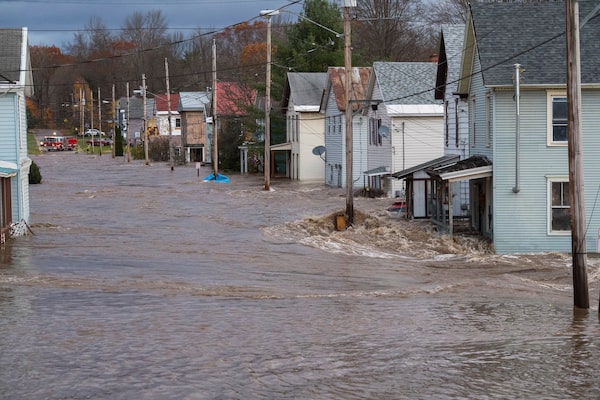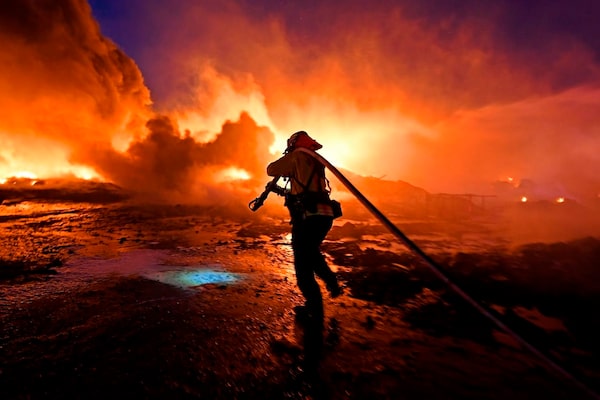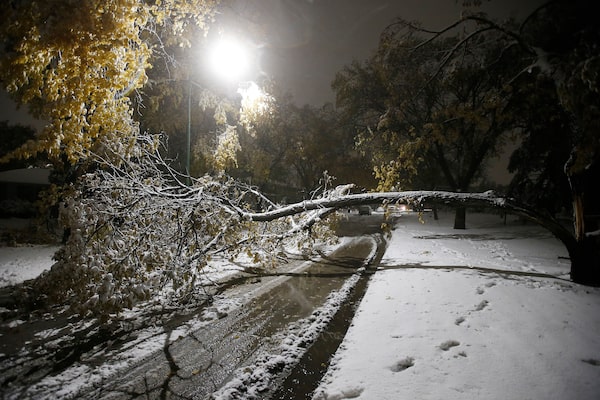
Author Amitav Ghosh, seen here, set himself the challenge of writing a beautiful story about climate change in his latest work, Gun Island.Ivo van der Bent/Handout
Tight, intricate plotting buoyed by loose, lyrical storytelling is at the heart of what makes an Amitav Ghosh novel so excellent. Both skills serve the author well in his latest, Gun Island, for which he set himself the challenge of writing a beautiful story about humanity’s biggest problem – climate change.
This is Ghosh’s eighth novel, and second time taking on the topic. His last work, The Great Derangement, was a non-fiction argument that only collective insanity explains humanity’s refusal to deal with the crisis. In it, he lamented the art world’s hesitancy to engage with the issue. He didn’t realize it would be quite so tricky attempting to do so himself.
“There are aspects of the modern novel which make it difficult to confront something like climate change,” Ghosh explained, pouring me a cup of turmeric tea at the University of Toronto in early October. One hurdle was the denial, or at least incredulity, with which many still respond to the climate emergency.
“The whole idea of serious fiction is that it has to be even more plausible than life,” he said. That’s difficult when implausible scenarios are a daily occurrence: Storms that once came every 50 years now flood towns every summer, as species disappear in front of our eyes.

Houses are flooded by rising waters of the East Canada Creek, on Nov. 1, 2019, in Dolgeville, N.Y. Ghosh says one of the troubles of writing about climate change is creating plausible scenarios, when the climate is currently filled with implausible scenarios now occurring constantly.Darren McGee/The Associated Press
Another snag was the problem’s vastness, across both time and space. “Even a novel which has a very long duration, like, let’s say, 100 Years of Solitude, is limited to 100 years,” he said. But today’s environmental problems are rooted in decisions made centuries ago, and addressing them requires imagining how actions taken here, today, will play out on the other side of the world, centuries into the future.
Modern literature failed his needs, but the 63-year-old did find a template to work with. Grand depictions of collective human precarity were abundant, he realized, in age-old myths, prophecies and folklore. And so, to craft the narrative of a cautious bookseller named Dinanath Datta, Ghosh built upon a ninth century legend from India, where he was born.
Gun Island isn’t the only recent book that weaves together images of environmental destruction with ancient stories about the human relationship to nature. It’s often an intrinsic approach in what University of British Columbia professor Daniel Heath Justice calls “Indigenous wonderworks,” a concept he set out in last year’s Why Indigenous Literatures Matter.
Currently the Canada Research Chair in Indigenous Literature and Expressive Culture, Heath Justice argues that seemingly surreal Indigenous stories should not be lumped in with other fantasy books, or speculative fiction. A wonderwork "reminds us that the ways things are is not how they have always been, nor is it how they must be. …” the member of the Cherokee Nation writes. “They allow us to imagine a future beyond settler colonial vanishings, a future where we belong.”

Gun Island isn’t the only recent book that weaves together images of environmental destruction with ancient stories about the human relationship to nature.
Two recent books show how broadly the idea can apply. The first is last year’s Split Tooth by Inuit musician Tanya Tagaq. Encompassing poetry, teen angst and colonial horror, it defies categorization, and that’s the point – as the unnamed heroine crisscrosses between real and imaginary worlds, she shows just how thin that barrier can be.
In non-fiction, there’s Our History Is the Future by academic and activist Nick Estes. Published earlier this year, it’s a more straightforward history of the Oceti Sakowin, people who live in the Plains area once known as the Great Sioux Reservation, overlapping parts of various midwestern United States. But as he moves from the mid-18th century through the present day, the University of New Mexico professor refuses to recognize any distinctions between scientific knowledge and so-called "superstition.”
Fair enough, since overconfidence in human technology is a big reason we’ve found ourselves in this climate predicament. All things considered, these three books make a good argument that solving the crisis requires getting over ourselves.

In this Oct. 27, 2019, file photo, a firefighter drags a hose closer to battle a grass fire on East Cypress Road in Knightsen, Calif.The Canadian Press
Gun Island’s central legend is of the goddess Manasa Devi, who controls all snakes and poisonous creatures. Ghosh adapts a story in which she follows an ungrateful merchant across seas and continents, unleashing her minions on him and his family.
In this interpretation, Dinanath finds himself struggling to reconcile his staunch belief in Western rationality with what seem to be 21st century run-ins with Manasa Devi, in the form of natural disasters and dangerous animals. His assertion that it’s all just coincidence is repeatedly, severely tested.
Ghosh blames the dearth of climate-disaster art on the modern preoccupation with individuality. He has Dinanath travel to Venice, where he visits Santa Maria della Salute. Built in 1630, the gorgeously appointed Catholic church was an offering to God during a terrible outbreak of the plague. “There was a sense in which people were creating something that they recognized to be social, collective, that was rooted within social practice,” Ghosh said of eras past.
That said, as climate grief and anxiety increase, the novelist has noted an emerging instinct toward ritual, community responses. Last summer, funeral ceremonies were held for disappearing glaciers in both Iceland and Switzerland.
“I think ordinary Westerners are beginning to see that their way of living on the land is ultimately very disruptive,” he said. “Some other mode of relating to the landscape has to be thought about. Where can we look?”

An early winter storm with heavy wet snow caused fallen trees and power lines in Winnipeg.JOHN WOODS/The Canadian Press
His search has pointed him toward communities that have already experienced the attempted destruction of their ways of life. “The Indigenous peoples of the Americas are … literally people who’ve seen the end of the world and they found ways of surviving,” Ghosh said. “Just think of the Indigenous peoples in the Great Plains, seeing absolutely the slaughter of the buffalo.”
By Gun Island’s thesis, it’s perhaps not a coincidence that the book I read right before Ghosh’s novel was Our History Is the Future, about the exact time and place he’s referencing. In it, Estes recounts the signing of the 1868 Fort Laramie treaty, in which the United States promised Lakota-, Dakota- and Nakota-speaking people access to the Plains “as long as the buffalo shall roam.”
Almost immediately afterward, it began purposefully overhunting the animal that the seven tribes of the Oceti Sakowin relied on for food, clothing, and much more. Buffalo skulls were piled on the Plains by the hundreds of thousands. Hides were taken and then carcasses poisoned to accelerate Indigenous starvation. Most tribes eventually moved to reservations, and the animal became virtually extinct.
A member of the Lower Brule Sioux Tribe, Estes opens his book on the 2016 protest against the Dakota Access Pipeline at the Standing Rock reservation. The camp was the culmination of more than a century of continual resistance, he writes, as his people never stopped fighting for their space on the Plains.
It was also the fulfillment of a vision had by Black Elk, an Oglala Lakota leader who Ghosh mentioned to me as well. Estes takes as a given the validity of Indigenous knowledge, including what he calls prophecy, not myth, or legend.
This knowledge begins with Oceti Sakowin origin stories, which all describe connections to the Plains land, Estes writes. The foundational tale of the people of Pte Oyate, or Buffalo Nation, concerns a formal, ancient treaty with that animal. In following strict rules for honourably taking buffalo lives, humans sustained not just themselves, but an entire ecosystem.
Grazing buffalo created healthy habitats for plants, insects and smaller animals. The buffalo slaughter destroyed this reciprocity. In treating the earth solely as a source of capital, Estes argues, colonialism has led the natural world to a state of revolt.
As with Dinanath, staunch rationalists might find his ideas difficult to grasp. Skeptics should note that Western researchers are constantly conceding to Indigenous wisdom about the natural world, from the habits of whales, caribou and nighthawks to the geography of the Arctic.
Up there, surrounded by melting permafrost, the unnamed heroine of Split Tooth has similar warnings about a warming world. “Earth’s whispers released back into the air can only wreak havoc,” she says early on.
Illustrated by cult comic artist Jaime Hernandez, Tagaq’s first book holds a multitude of genres. Pages of poetry are slipped between darkly comic tween and teen high jinks. But it’s also a terrifying horror story, one driven by colonizer-induced traumas and populated with otherworldly monsters, including the Inuit sea goddess Sedna.
“I saw in an instant the spiritual world we all ignore,” the protagonist says at one point, as she welcomes a man-sized fox into her home.
Tagaq’s heroine isn’t as invested in rationality as Ghosh’s Dinanath, but 21st century life has distanced her from non-human beings. It’s a problem shared with many of the more than 10,000 people who spent time at the Dakota Access camp, which “force[d] some to confront their own unbelonging to the land and to the river,” Estes writes. That pretty much describes Dinanath, too, a witnesses to nature’s distress who feels clueless as to how to respond.
As with Gun Island, the Standing Rock resistance was centred by a serpentine legend: that of Zuzeca Sapa, a black snake “extending itself across the land and imperiling all life, beginning with the water.” To anti-pipeline activists, the Black Snake is reality, not metaphor. And in a moment of daydreaming, Dinanath realizes the same of Manasa Devi.
Finally softening his barriers between this world and another, the bookseller sees that the snake goddess isn’t vengeful but desperate. As an intermediary between humans and animals, she’s warning that the refusal of one to respect the other will lead to, quite literally, the end of the world.
“How can a translator do her job if one side chooses to ignore her?” Dinanath muses. “The quest for profit,” he sees, has destroyed a crucial sense of “restraint in relation to all other living things.”
Ghosh has successfully intertwined stark facts – such as boats of desperate migrants refused harbour by Mediterranean countries – with imaginative fantasy (no spoilers, but there are dolphins). His is a bit of a wonderwork, too, conjuring up a world where the urgency of finding harmony with other living things is a human priority.
By book’s end, Dinanath believes that the path forward is summed up in an inscription in the church of Santa Maria Della Salute: Unde Origo Inde Salus, meaning “from the beginning salvation comes.” Or, to restate the title of Estes’s book, Our History Is the Future.
Tagaq is more blunt in Split Tooth, perhaps because her far north homeland is warming so much faster than the rest of the world.
“Only the patterns of skills gifted by our ancestors keep us living in harmony,” her storyteller warns. “We obey or we succumb.”
Expand your mind and build your reading list with the Books newsletter. Sign up today.